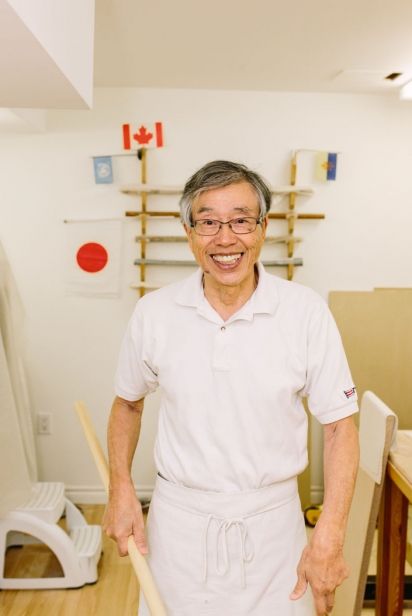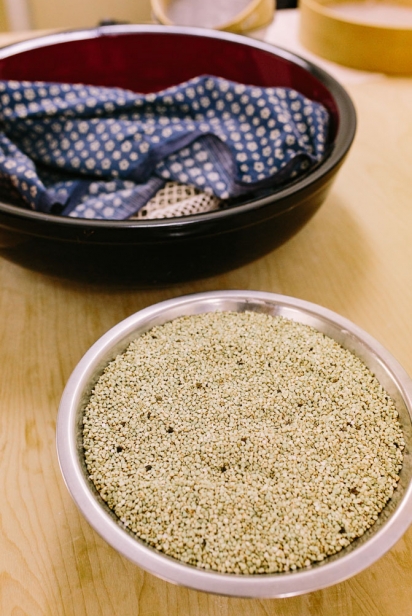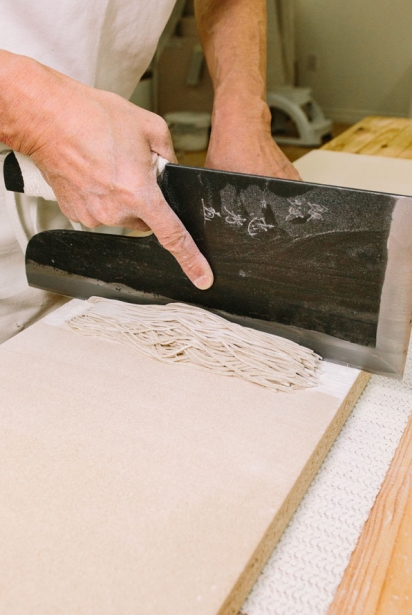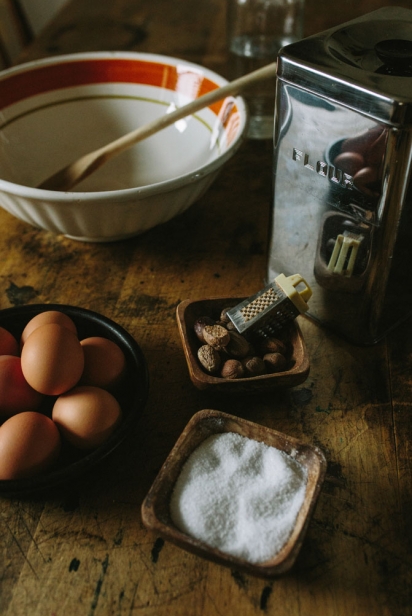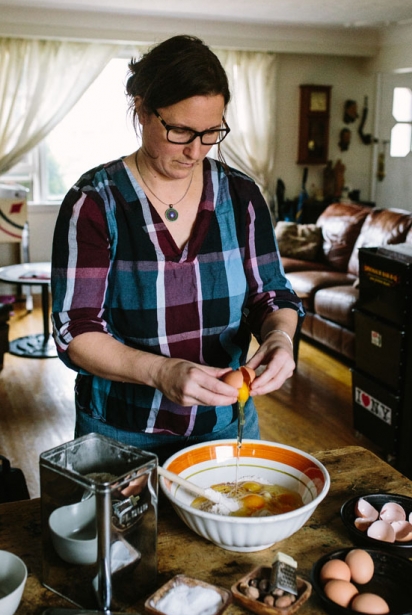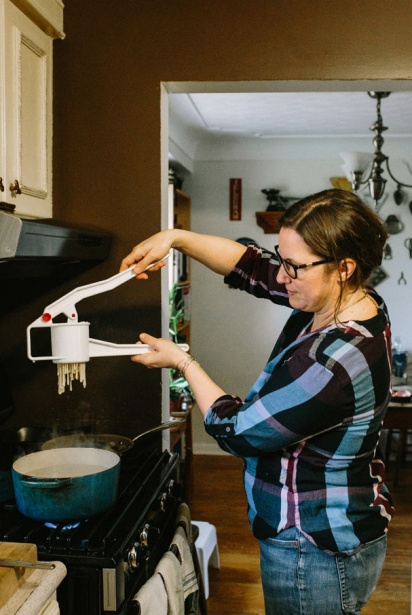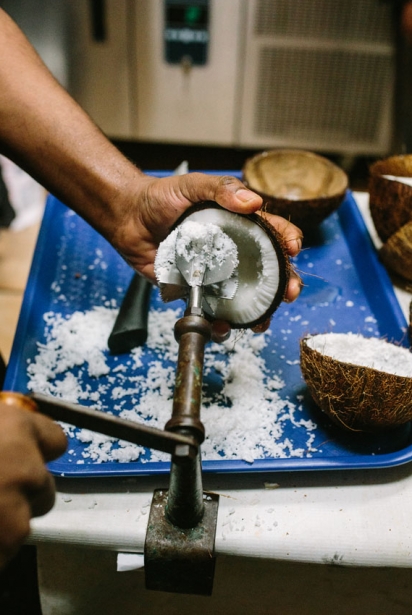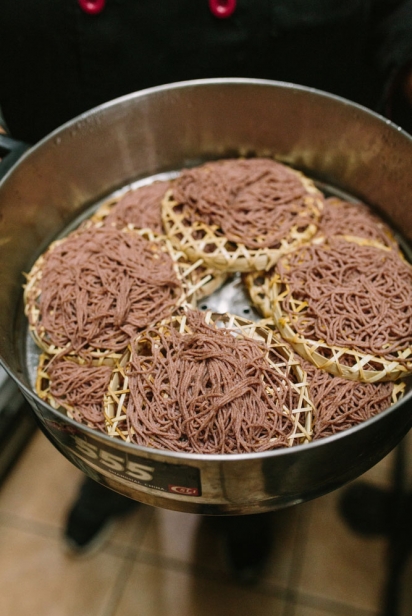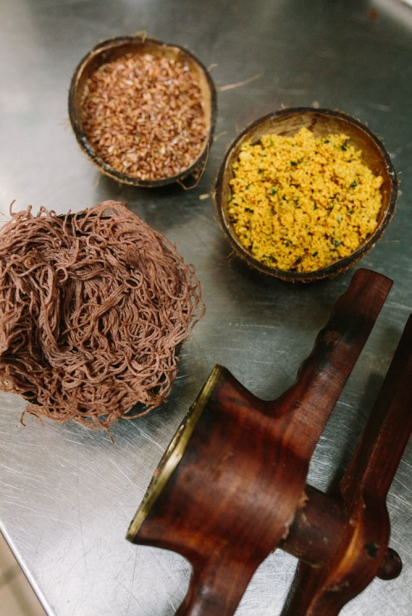Soba, Spaetzle and String Hoppers
Think of the ultimate comfort foods in our lives and there’s more than a good chance that one of them involves noodles. Gooey mac 'n' cheese, slurpy pho, thick and chewy Tianshui — the world devours carbs no matter their shape, even their colour (here’s looking at you, squid-ink pasta.)
Nearly every country on the map has a noodle dish or 200 of them (which, sadly, we couldn’t include all in this issue.)
Soba: Japan
It was a curiosity about Canadian buckwheat that ultimately drove Ted Iizuka to become a soba master.
Iizuka, who hails from Tokyo, arrived in Canada in 1996 to work for a subsidiary of the Japanese shipping company that employed him for nearly 30 years in his homeland and, in his spare time, he started researching Canadian buckwheat.
He learned Canada grew about 25,000 tons of the grain-like plant at the time — the same amount Japan farmed. But Canadians, unlike the Japanese, were not familiar with the crop.
“Knowing that Canada was growing buckwheat, I was curious about it. I wanted to eat it. I looked for it in restaurants, but no one was using it,” Iizuka recalls. “Buckwheat is so well-balanced as a food. It’s a superfood, but there’s no appreciation.”
It turns out that 80 per cent of Canada's crop was exported to sate the Japanese appetite for soba, the word for buckwheat in the island nation.
So to eat Canadian buckwheat, Iizuka quit his shipping job in 2000 and headed back to Japan to enrol in soba school. During two months of intensive training there, he learned buckwheat was once considered a seasonal food before it became a commercial crop. He then spent the next 10 months working in restaurants to perfect his noodle-making technique, making mostly Ni-hachi soba, which is a mix of 80-per-cent naturally gluten-free buckwheat flour, 20-per-cent wheat flour as a binder and water.
His was a far simpler route to glory than the original soba masters of the Edo period more than 350 years ago, who enlisted in an apprenticeship lasting a minimum of five years and three months.
When Iizuka returned to Canada, he set out to find high-quality buckwheat, but the commoditization of the crop made that difficult. “The people working in the commercial system are lacking the attachment [to their crop]. They can’t explain what kind of buckwheat it is, the conditions [it’s grown in].”
Iizuka drove around rural Manitoba until he found someone “heart-driven” rather money-driven who would sell him fresh buckwheat groats that he could ship home to Mississauga, vacuum pack and freeze, so he could grind them only as needed to make fresh soba. It’s a method that ultimately preserves the aroma and integrity of the buckwheat, he explains.
He makes his noodles to the Edo standard, flattening the dough to 1.3 millimetres, then folding and cutting it, getting 23 slices from every inch. The result is a perfect square noodle that he now serves hot or cold to a maximum of 25 diners once a week on Tuesdays, at Ichiriki Japanese Restaurant in Toronto.
Soba is so thin, “it’s like you’re drinking it, not chewing,” he explains, and they must be eaten as soon as served; otherwise they lose their texture. Diners typically dip the noodles in sauce and slurp them noisily, but the 72-year-old soba master concedes on that rule, knowing Canadians prefer to eat their food quietly.
No matter how they’re eaten, Iizuka’s soba, made with only two or three ingredients, is as much philosophical as nourishing. It represent creating something for love rather than money.
“I’ve worked in big companies… and I don’t like such styles of work,” Iizuka says. “What I can do through soba, it encourages a way of thinking, a way of life that’s my life now. Soba is just the material to convey such a way of life.”
Spaetzle: Germany
There’s a tool in Mia Bachmaier’s kitchen at her home in Burlington that doesn’t get much use. A gift from her brother, a chef in Heilbronn, Germany, it looks like a potato-ricer. But to Bachmaier, also a chef, food stylist and cookbook author, the contraption that’s a spaetzle press is a no-no when it comes to making the German egg noodle that originated with the Swabian people in Baden-Württemburg, the southwestern part of Germany, bordering France.
Bachmaier, who trained in Germany and cooked in her family’s hotel near the Austrian border before meeting her Canadian husband, learned how to make spaetzle the traditional way using a one-to-one mixture of eggs and flour, and spreading dough onto a thin wooden board with a handle called a spaetzlebrett. The dough is then scraped in a quick motion into a pot of boiling water to cook until it floats.
But back in the kitchen of her family’s hotel in Anger, Bavaria, Bachmaier would forgo the board to do a Bavarian spin on spaetzle, which means little sparrow. Bachmaier would make Knöpfle, or “buttons,” by dragging her dough over a cheese grater-like contraption called a spaetzlehobel. The comforting bits of carbs were a staple at weddings in the hotel banquet hall, where they were served as a side dish with cream sauce or gravy. Kitchen staff would make spaetzle dough in 10-kilogram batches, stirring the heavy mixture by hand until it started “throwing bubbles” and was aerated.
The spaetzlehobel is quicker and easier to use than the board method, but that spaetzle press? It represents cutting corners to Bachmaier. The holes in the press are different shapes and sizes to mimic the imperfectly shaped spaetzle that's scraped from a board.
“That’s how you fake them,” she says.
Still, many chefs will use the press for ease and speed in a busy kitchen. They also play with the classic recipe of just eggs and flour. Some will add mineral water to lighten their spaetzle, pronounced shpetz-luh.
But few deviate from how it’s eaten, as the carb alongside a roast, with a stew, or one of Bachmaier’s favourite ways: boiled then fried and tossed with grated Swiss or Gouda cheese, and topped with fried bread crumbs.
Despite eschewing that press, Bachmaier concedes to each their own when it comes to this German staple.
“Everyone does it differently. There is no right or wrong [way],” she says. “It’s just comfort, really. When I go back to anything I make that I can make in my sleep, it’s a comfort for me, especially in my kitchen where I know where everything is.”
String Hoppers: Sri Lanka
There was a time when chef Suganthy Muthukumar made string hoppers every day, but since opening her Applespice restaurant on the border of Scarborough and Markham, that ritual is down to once a week.
It’s not that making string hoppers, a Sri Lankan noodle that originated in times B.C., is difficult. But it is time-consuming, just like running a South Asian take-out spot with her husband Muthu and her mother, Malar.
Muthukumar could buy string hoppers in a store to get her fix, but they just don’t cut it for this purist, who doesn’t even sell them at her eatery because she refuses to take shortcuts in the labour-intensive process.
“If I make it, I have to make it properly,” Muthukumar says. “Maybe when I expand [my restaurant], I’ll think about it.”
Proper string hoppers, called Idiyappam in Tamil, start with flour, but not wheat, which is a relatively new crop to Sri Lanka. It has to be a flour of red rice, quinoa or millet. Muthukumar tends to prefer red rice, grinding a mix of raw and polished grains herself with a stone or iron mortar and pestle after soaking them for four hours and air-drying for another hour.
“If you want an authentic taste, you use real ingredients,” she says.
The flour is then mixed with water to create a light pink paste that's pressed through an extruder made from the wood of a poovarasan tree, a tree found on South Asian coasts that keeps its integrity underwater and is believed to have health benefits. A more modern metal press that’s cranked like a pepper mill can also be used to make the wiry noodle.
Raw string hoppers are pressed onto small, woven bamboo discs and stacked in a pot for steaming. The result looks like little nests of pinkish-brown noodles that are torn and mixed with sweet or savoury accompaniments before being eaten by hand.
“You can make it with anything and everything,” Muthukumar says. “At night, it’s more often with a lot of curries. For breakfast, it’s simple — sambal and a little (coconut) gravy.”
The benefit of eating string hoppers, which are common fare in agrarian villages in Sri Lanka and southern India, is that they don’t cause bloating or feel heavy in the belly — a benefit to the workers who ate them. But with cheaper wheat flour now being used to make them, string hoppers have merely become food “to fill tummies,” says Muthukumar, who left Jaffna, Sri Lanka, with her family in 1996 to escape the civil war.
“When a person is making a string hopper with wheat flour, it’s cheap,” she says. “But the traditional string hopper, it’s a hard process. I want to teach these things to the younger generations. I think they’re missing out. Everyone knows what it is, but they don’t know the reason why it is.”
Applespice Restaurant
Unit 122, 3341 Markham Rd., Scarborough
applespicerestaurant.com | 416.321.3456 | @applespicerestaurant
Orecchiette: Italy
These tiny durum-wheat discs with a depression in the centre are named “little ears” in Italian for their resemblance to a small ear. Orecchiette originated in southern Italy, and are ridged on the domed side, smooth on the other, making them ideal vessels for catching and holding sauce.
They’re made by cutting tiny cubes of pasta dough that are simultaneously pressed and dragged with a knife to make a curl that’s inverted over the thumb.
There are a few variations of this pasta that’s said to be best suited to vegetable sauces. In Cisterno, on Italy’s southeastern coast, for example, the noodles are made larger and have deep internal ribs. They’re called recchie d’privte, or priest’s ears.
Good substitutes, if no orecchiette is within reach, include cavatelli, a small, curled pasta shell, or gnocchetti, a curved, ridged noodle made to look like the gnocchi dumpling.
Scialatelli: Italy
This is a noodle with some serious heft. Think of it as a shorter, thicker fettuccine.
Scialatelli means ruffled and the noodles, whose origins are on the Amalfi Coast, look like ruffled hair when cooked and plated. They’re handmade and cut, giving them irregular shapes and sizes. Scialatelli were originally created by Chef Enrico Cosentino in the 1960s, making them the baby of the Italian noodle family. In the original recipe, Cosentino used a mix of durum wheat, extra-virgin olive oil, eggs, Parmesan and milk. The rustic noodle brought him fame in 1978 when he won an international culinary competition with it.
Scialatelli dough is worked by hand, kneaded into a ball and left to rest for half an hour, after which it’s flattened to thick sheets, trimmed to 10 to 12 centimetres long, and cut with a chef’s knife to the width of something between linguine and fettuccine. Think of these chubby noodles as Italy’s answer to German spaetzle, but instead of topping them with cream sauce or gravy, scialatelli are tossed with gently cooked, melty tomatoes, olive oil and fresh basil.
Gnocchi: Italy
Some say noodle, others say dumpling. However you classify it, gnocchi are glorious pillows of toothsome goodness. Gnocchi — gnoccho in the singular — can be made many ways. Some might be ardent supporters of Team Semolina gnocchi. Others might prefer wheat flour to make their dough. Others still, pad out their flour mixture with potatoes or opt for ricotta as the glue that holds everything together. The raw materials depend on the region where the gnocchi are made, but it shows that the rules for making gnocchi aren’t rigid.
Take the fact that they’ve existed since Roman times, but in the 16th century, when potatoes made their way across Europe, the recipe was modified to include starchy spuds, which give gnocchi a lighter, fluffier texture.
No matter the ingredients, the method for making these dumplings is a variation on a theme. The dough is rolled into ropes and cut into small pieces. Some cooks leave the pieces as is with a smooth surface. Purists might be inclined to roll them along the tines of a fork or a wooden board with ridges made specifically for giving gnocchi the indentations that are like magnets for sauce.
Chow Fun: China
These noodles might have the best name ever. They’re no slouch when it comes to being a joy to eat, either, which is why they’re among the most commonly consumed Chinese noodles in the world. Chow fun resemble Italian tagliatelle. They’re a flat, wide rice noodle with a chewy texture, most often used in stir-fried dishes, including beef chow fun, a Cantonese mainstay. But they’re no strangers to adding substance to soups, either.
The noodles, also known as hor fun or Shahe fen, originated in the Shahe district of Guangzhou on the Pearl River in southern China. They can be purchased fresh or dried and mixed with steak, soy sauce, oyster sauce, sesame oil and scallions for quintessential beef chow fun.
Still, for the DIY types, recipes exist online to make your chow fun noodles using non-glutinous rice flour mixed with corn starch, cold water and vegetable oil. Cooks steam the concoction in thin sheets that can be rolled and cut into ropes for frying or slurping.
Fideos: Spain
Think of noodle nations and Spain likely won’t be the first to come to mind. But the land of pintxos and Jamón ibérico has a deep appreciation for a noodle similar in shape and size to what you’d find in a can of chicken noodle soup.
The Spanish take on pasta is called fideos, pronounced fee-dayohs, and it usually comes in the form of thin, round noodles somewhere between capellini and spaghetti on the thickness scale. The noodles are made of durum semolina, but that’s where the similarities to their Italian cousins end, particularly when preparing fideos.
Dry fideos are sometimes toasted in olive oil before cooking. And instead of being boiled in water and covered in Sunday gravy, fideos are cooked directly in sauce until juicy rather than al dente. They can also be used in anything from soups to paella. Fideos are the star of cazuela, a casserole that can include seafood or pork, and is cooked and served in an earthenware pot.
E-fu: China
Attend a Chinese birthday party or New Year’s celebration and there’s a good chance the host will serve E-fu noodles. These long pale-yellow cords are known as the longevity noodle; its length — and consumption — a symbol of a long life.
Also known as Yi mian, these Cantonese noodles are made primarily with egg and wheat flour. Their foam-like, chewy texture is thanks to the carbonated soda water used to wet to the dough, an effect enhanced by the fact that E-fu are fried before being dried.
The noodles are round rather than flat, and they’re thick. The key to cooking them, according to many Asian food bloggers, is to ignore the instructions on the package. The boiling times will make them mushy and these are noodles whose slightly dense chew you want to maintain.
E-fu lends itself to many purposes. It's brilliant in stirfries, swimming in brothy soups, or holding its own in salads.
Reshteh: Iran
Shaped like linguine, reshteh noodles are said to bring good fortune, making them a fixture during the Persian New Year celebration of Norwuz. These whole-wheat noodles are thin and flat, similar to kesme, a Turkic noodle found throughout an area stretching from Siberia to Kazakhstan, Turkey to Iran, and within Crimea and the Balkans.
Reshteh, which means string in Farsi, is used to make a thick Persian soup called Ash-Reshteh that’s eaten in winter. The dish uses kashk, which is Persian whey, herbs, spinach, chickpeas, lentils and turmeric. Flour thickens the broth and gives it more body.
Another common dish, Reshteh Polo is a vegetarian pilaf that features the noodles fried or toasted with long grains of rice and spices. It’s believed that eating Reshteh Polo at New Year helps you grab hold of your destiny for 12 months ahead.



